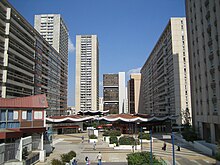Quartier asiatique

TheQuartier asiatique(Asian Quarter), also calledTriangle de ChoisyorPetite Asie(Chinese:Ba lê đường nhân nhai,Vietnamese:Phố Tàu Paris) is the largest commercial and cultural center for the population of Asian origin ofParis.It is located in the southeast of the13th arrondissementin an area that contains many high-rise apartment buildings. Despite its status as a "Chinatown",the neighborhood also contains significantVietnamese,LaotianandCambodianpopulations.
History
[edit]The first wave of Asian immigrants to the neighborhood consisted of ethnic Vietnamese refugees from theVietnam Warduring the late 1970s. Later waves of migrants consisted ofethnic Chinese from Vietnam,Laos and Cambodia, who also fled their countries following their communist takeovers and to avoid persecution by the new governments. A significant number of the earlier Vietnamese immigrants integrated into French society shortly after their arrival, and began moving to other areas of Paris and the surroundingÎle-de-Franceregion, while still maintaining a commercial presence in the area.[1]This left the neighborhood having a larger ethnic Chinese presence, and thus led to a creation of the present-day "Chinatown".
Neighborhood
[edit]
The Quartier Asiatique forms an area roughly the shape of a triangle bounded by Avenue de Choisy, Avenue d'Ivry and Boulevard Masséna, as well as theLes Olympiadescomplex. Within this neighborhood, commercial activity is dominated by Chinese and Vietnamese businesses, with a smaller number of Laotian and Cambodian establishments. The large French Asian specialty market chains ofTang FrèresandParistorealso have their flagship locations within the quarter. As the focal point for the Asian population of the Île-de-France region, a number of community organizations are headquartered here, helping to serve immigrant needs and cultural activities, especially for those from the formerFrench Indochina.The annualLunar New Yearparade within the neighborhood is largest in Paris.
Unlike other Chinatowns in the Western world,Chinese architectureis not highly visible in the area, with an exception being the severalBuddhist templeslocated throughout the district.
Demographics
[edit]The Quartier Asiatique is the largest Chinatown in Europe, and unlike the diminutive but well-knownChinese districtaroundGerrard StreetinLondon's Soho,it represents a significant population center as the result of very considerable immigration. The area is populated by nearly 50,000 people, largely of Chinese, Vietnamese and Laotian descent.
Originally anethnic Vietnamese quarter,the Asian population in the area diversified in the 1980s as other ethnic groups from Indochina also settled in the district, the largest group being ethnic Chinese. While a large proportion of the neighborhood's earlier Vietnamese population assimilated into French society and moved to other areas of Paris, they still maintain a strong commercial and cultural presence in the district.
Languages used among immigrant groups in the community include theCantoneseandTeochew dialectsof theChinese language,as well asVietnamese,LaoandKhmer.Ethnic Chinese refugees are often conversant in one of the latter three languages in addition to their native Chinese dialect, due to their origins from Indochina.
Similar communities
[edit]Paris also hosts three other Asiatic districts within its limits. The most notable is that of theBellevilleneighborhood in the20th arrondissement.Unlike Chinatown and the 13th arrondissement, ethnic Chinese from Indochina form a minority of the neighborhood's overall and Asian population. Ethnic groups from Indochina also do not have a significant presence in the Belleville community. Instead, the vast majority of Belleville's ethnic Chinese population consists of those with origins from the eastern Chinese coastal city ofWenzhouand surrounding southernZhejiang province.[2]
Meanwhile, the oldest but smallest Asian neighborhood in Paris is located in the3rd arrondissement,near theMusée des Arts et Métiers.It is bounded roughly byRue au Maire,Rue Volta, Rue du Temple and Rue des Gravilliers. The district was established in the early 1900s, when Chinese migrants specializing in the leather and Chinese porcelain industries arrived in Paris from the Wenzhou region. DuringWorld War I,a large number ofChinese laborers,also principally from Wenzhou, were recruited by the French Empire to help with war efforts in the country. The small number who decided to stay in France after the war also settled in the district.[3]
SInce the 1990s, a Japanese quarter has been developing alongRue Sainte-Annein the1st arrondissementnear thePyramidesMétro station. The area hosts a number of Japanese restaurants and specialty boutiques, along with branch offices of the Japan National Tourism Organization andJapan Airlines.In recent years, aKoreanpresence has also been established in the same area.
Gallery
[edit]-
Mix of culture in theTriangle de Choisy.
-
Chinese New Yearparade in 2015.
-
Chinese New Yearparade.
-
TeochewAssociation in France.
See also
[edit]References
[edit]- ^La Diaspora Vietnamienne en France un cas particulierArchived2013-12-03 at theWayback Machine(in French)
- ^Belleville: un mélange pas si explosive,June 2010 (in French)
- ^Le Quartier Chinois de Paris Arts-et-Métiers(in French)




